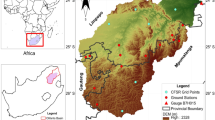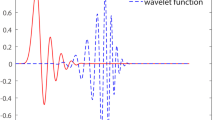Abstract
This chapter develops intelligent data analytics approaches to compare the frequently used drought-monitoring indices and applies the change-point analysis technique to detect subtle changes in the drought index trends for natural hazard and disaster risk mitigation. The Standardised Precipitation-Evapotranspiration Index (SPEI), used in this chapter, is able to identify extreme drought events better than the Standardised Precipitation Index (SPI). SPEI highly correlates with Precipitation-based Drought Indices (DIs), especially with SPI and Rainfall Decile-based Drought Index (RDDI) but can additionally provide complementary information about hydrological effects of drought. Illustrated by the wavelet analysis, the SPEI concurs with all major drought events largely, significant at 95% confidence interval, compared to SPI, RDDI and Rainfall Anomaly Index (RAI). The change-point analysis is able to detect changes in the SPEI trend with associated confidence levels and confidence intervals. The study found the location R4 (in arid/semi-arid region) to have undergone 26 changes in SPEI trend compared to R1, R2 and R3 with 0, 9 and 6, respectively. The location of study matters where inland from the coastline experiences more variability in the environmental parameters that define the SPEI. The methods proposed this chapter can be useful for disaster risk mitigation, particularly, quantifying drought events for decision-making processes.
Access this chapter
Tax calculation will be finalised at checkout
Purchases are for personal use only
Similar content being viewed by others
References
Allen RG, Pereira LS, Raes D, Smith M (1998) Crop evapotranspiration-Guidelines for computing crop water requirements-FAO Irrigation and drainage paper 56. FAO Rome 300(9):D05109
Barbeta A, Ogaya R, Peñuelas J (2013) Dampening effects of long-term experimental drought on growth and mortality rates of a Holm oak forest. Glob Change Biol 19(10):3133–3144
Cavin L, Mountford EP, Peterken GF, Jump AS (2013) Extreme drought alters competitive dominance within and between tree species in a mixed forest stand. Funct Ecol 27(6):1424–1435
Chang T-P, Liu F-J, Ko H-H, Huang M-C (2017) Oscillation characteristic study of wind speed, global solar radiation and air temperature using wavelet analysis. Appl Energy 190:650–657
Das PK, Dutta D, Sharma J, Dadhwal V (2016) Trends and behaviour of meteorological drought (1901–2008) over Indian region using standardized precipitation–evapotranspiration index. Int J Climatol 36(2):909–916
Dayal K, Deo R, Apan A (2018) Investigating drought duration-severity-intensity characteristics using the Standardised Precipitation-Evapotranspiration Index: case studies in drought-prone southeast Queensland. J Hydrol Eng 23(1)
Deo RC, Syktus J, McAlpine C, Lawrence P, McGowan H, Phinn SR (2009) Impact of historical land cover change on daily indices of climate extremes including droughts in eastern Australia. Geophys Res Lett 36(8)
Deo RC, Şahin M (2015) Application of the extreme learning machine algorithm for the prediction of monthly Effective Drought Index in eastern Australia. Atmos Res 153:512–525
Fuchs B, Svoboda M, Nothwehr J, Poulsen C, Sorensen W, Guttman N (2012) A new national drought risk Atlas for the US from the National Drought Mitigation Center
Gibbs WJ, Maher JV (1967) Rainfall deciles as drought indicators. Bureau Meteorol 48
Hanson RL (1988) Evapotranspiration and droughts. In: Paulson RW, Chase EB, Roberts RS, Moody DW (eds) Compilers, national water summary, pp 99–104
Hobbins M, Wood A, Streubel D, Werner K (2012) What drives the variability of evaporative demand across the conterminous United States? J Hydrometeorol 13(4):1195–1214
Grinsted A, Moore JC, Jevrejeva S (2004) Application of the cross wavelet transform and wavelet coherence to geophysical time series. Nonlinear Process Geophys 11(5/6):561–566
Li W, Hou M, Chen H, Chen X (2012) Study on drought trend in south China based on standardized precipitation evapotranspiration index. J Nat Disasters 21:84–90
Keyantash J, Dracup JA (2002) The quantification of drought: an evaluation of drought indices. Bull Am Meteor Soc 83(8):1167–1180
Martin-Benito D, Beeckman H, Canellas I (2013) Influence of drought on tree rings and tracheid features of Pinus nigra and Pinus sylvestris in a mesic Mediterranean forest. Eur J Forest Res 132(1):33–45
McKee TB, Doesken NJ, Kleist J (1993) The relationship of drought frequency and duration to time scales. In: Proceedings of the 8th conference on applied climatology, american meteorological society Boston, MA, pp 179–183
Paulo A, Rosa R, Pereira L (2012) Climate trends and behaviour of drought indices based on precipitation and evapotranspiration in Portugal. Nat Hazards Earth Syst Sci 12:1481–1491
Potop V (2011) Evolution of drought severity and its impact on corn in the Republic of Moldova. Theoret Appl Climatol 105(3–4):469–483
Raupach M, Briggs P, Haverd V, King E, Paget M, Trudinger C (2009) Australian water availability project (AWAP): CSIRO marine and atmospheric research component: final report for phase 3. In: Centre for Australian weather and climate research (bureau of meteorology and CSIRO). Melbourne, Australia
Raupach M, Briggs P, Haverd V, King E, Paget M, Trudinger C (2012) Australian Water Availability Project. CSIRO Marine and Atmospheric Research. Canberra, Australia
Roderick ML, Rotstayn LD, FarquharGD, Hobbins MT (2007) On the attribution of changing pan evaporation. Geophys Res Lett 34(17)
Sheffield J, Wood EF, Roderick ML (2012) Little change in global drought over the past 60 years. Nature 491(7424):435–438
TaylorWA (2000) Change-point analysis: a powerful new tool for detecting changes
Torrence C, Compo GP (1998) A practical guide to wavelet analysis. Bull Am Meteor Soc 79(1):61–78
Toromani E, Sanxhaku M, Pasho E (2011) Growth responses to climate and drought in silver fir (Abies alba) along an altitudinal gradient in southern Kosovo. Can J For Res 41(9):1795–1807
Van Rooy M (1965) A rainfall anomaly index independent of time and space. Notos 14:43–48
Vicente-Serrano SM, Beguería S, López-Moreno JI (2010) A multiscalar drought index sensitive to global warming: the standardized precipitation evapotranspiration index. J Climatol 23(7):1696–1718
Vicente-Serrano SM, Gouveia C, Camarero JJ, Beguería S, Trigo R, López-Moreno JI, Azorín-Molina C, Pasho E, Lorenzo-Lacruz J, Revuelto J (2013) Response of vegetation to drought time-scales across global land biomes. Proc Natl Acad Sci 110(1):52–57
Zajaczkowski J, Wong K, Carter J (2013) Improved historical solar radiation gridded data for Australia. Environ Model Softw 49:64–77
Author information
Authors and Affiliations
Corresponding author
Editor information
Editors and Affiliations
Rights and permissions
Copyright information
© 2021 Springer Nature Singapore Pte Ltd.
About this chapter
Cite this chapter
Dayal, K.S., Deo, R.C., Apan, A.A. (2021). Intelligent Data Analytics for Time Series, Trend Analysis and Drought Indices Comparison. In: Deo, R., Samui, P., Kisi, O., Yaseen, Z. (eds) Intelligent Data Analytics for Decision-Support Systems in Hazard Mitigation. Springer Transactions in Civil and Environmental Engineering. Springer, Singapore. https://doi.org/10.1007/978-981-15-5772-9_8
Download citation
DOI: https://doi.org/10.1007/978-981-15-5772-9_8
Published:
Publisher Name: Springer, Singapore
Print ISBN: 978-981-15-5771-2
Online ISBN: 978-981-15-5772-9
eBook Packages: Intelligent Technologies and RoboticsIntelligent Technologies and Robotics (R0)




